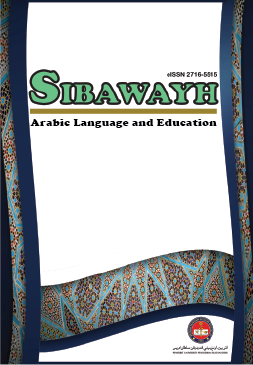شعر النقائض الاسلامية في عصر النبوة
The prefabrication poetic in the era of the prophecy
DOI:
https://doi.org/10.37134/sibawayh.vol3.1.10.2022Keywords:
Islamic contradictions, Veteran poetry, poetry of Islamic conquestsAbstract
When studying the poetry of Islamic contradictions in the era of prophecy, it is better for us to briefly familiarize ourselves with the nature of this art, and the nature of its artistic origins, while shedding light on the emergence of this art and its development in the pre-Islamic era, to be aware of the features of the development that befell it in the shadow of Islam. And through his battles with the League of Shirk in the period we are talking about.
These contradictions are also an extension of the contradictions of ignorance, in terms of their artistic origins, and the predominance of pre-Islamic meanings in the poetry of the two sides, and their limitation to pre-Islamic purposes, the most important of which are: satire, pride, lamentation, and its rotation in wars and days.
The dispute between the tribes in the pre-Islamic era requires poets to be intolerant of their tribes, so we often find a poet who triumphs over his people, and the poet of the hostile tribe responds to him and contradicts his meanings, and their most reliance is on pride or satire or on both - as we said -.
Hence, it is clear that poetry has three environments: Makkah, Madinah, and the Badia. In this period, poetry has turned to the cities: Makkah and Madinah, and is almost confined to the desert, so that the poets of the desert themselves tend to one of the two quarreling camps: Muslims and polytheists. The Islamic contradictions of the era of the Messenger (peace and blessings of God be upon him and his family) were a defense of a general belief and human principles on the part of Muslim poets, and some Islamic meanings and expressions leaked into examples of them. It revolves around disbelief, Islam, guidance, misguidance, resurrection, reward, heaven, hell, and others. These meanings and expressions are found in the contradictions of Abdullah bin Rawahah and Ka’b bin Malik, while the meanings remained pure ignorance in the contradictions of poets. Quraish and most importantly. The research attempts to give a clear picture of Islamic contradictions by referring to distinct examples of their poetry. Thus, Islam took positions on poetry that were compatible with the nature and nature of each stage of the call and its circumstances, and therefore “it is not correct to say that religion has turned a blind eye to poetry and forbade it, just as it is not correct to say that it encouraged poetry without guidance and discipline.”
Downloads
References
Ibrahim Abdul Rahman Mohammed. (1981). Issues of Poetry in Arab Criticism. Beirut: Dar al-Awda.
Son of Rashik Kairouani. (1981). The Mayor in the Beauties of Poetry, its Literature and Criticism. Beirut: Dar al-Jabal.
Ibn Qutaiba. (1934). Knowledge. Cairo: Islamic Press in Egypt.
Abu Ali Ismail al-Qali. (1926). Hopes and Rarities. Cairo: Egyptian Book House.
Ahmed Al-Shayeb. (1946). History of Contradictions in Arabic Poetry. Cairo: Union Press.
Ahmed bin Zeini Dahlan. (2012). Prophetic biography and Mohammedan antiquities. Damascus: Dar al-Nawader.
Ahmed, A.F. (1963). Diwan Al-Bahtari . Cairo: Dar Al-Maaref.
Honorary devotion. (1992). Islam and Poetry An Objective Study. Cairo: Library of Literature.
Dr. Hassan Nassar. (1973-1981). Diwan Ibn Rumi. Cairo: Dar Al Kuttab Press.
Sami Makki Alani. (1992). Looks at the poetry of the chest of Islam. Baghdad: House of Public Cultural Affairs.
Suleiman Ta'an. (2017). Towards a New Vision for the Issue of Weak Poetry in the Breast of Islam. Baghdad: Al-Mawrid Magazine.
Shawki Deif. (1960). History of Arabic Literature, Islamic Era. Cairo: House of Knowledge.
Salahuddin Al-Hadi. (1988). Literature in the Age of Prophecy and Adults. Cairo: Al-Khanji Library.
Amer Ahmed Haidar. (2005). The Tongue of the Arabs by Ibn Manzar. Beirut: Scientific Books House.
Aisha Abdul Rahman. (1967). New Values of Ancient and Contemporary Arabic Literature. Cairo: House of Knowledge.
Abd al-Salam Muhammad Haroun. (1965). The animal for protruding. Cairo: Mustafa Al-Babi Al-Halabi Press.
Abdul Qader al-Baghdadi. (1997). Treasury of Literature and the Pulp of the Pulp of the Tongue of the Arabs. Cairo: Al-Khanji Library.
Abdul Qader Al-Qat. (1979). In Islamic and Umayyad poetry. Beirut: Arab Renaissance House for Printing and Publishing.
Mark Catremer. (1858). Introduction of Ibn Khaldoun. Paris: Lebanon Press.
Mahmoud Shakir. (1998). Layers of stallions of poets by Ibn Salam. Cairo: Madani Press.
Mahmoud Mustafa. (1937). Arabic literature and its historiography in the era of the Sadr of Islam and the Umayyad state. Cairo: Mustafa Al-Babi Al-Halabi & Sons Press.
Mustafa Al-Sioufi. (2008). History of Literature at the Forefront of Islam. Cairo: International House for Cultural Investments.
Makki Alani. (1966). Diwan Kaab bin Malik Al-Ansari. Baghdad: Dar al-Maaref Press.
Nouri Hamoudi al-Qaisi, Bahgat Abdul Ghafoor al-Hadithi, and Mahmoud Abdullah al-Jader. (D.T.) Texts from Arabic poetry in the foreground of Islam and the Umayyad era. Baghdad: Directorate of Dar al-Kutub for Printing and Publishing.
Yahya al-Jubouri. (1964). Veteran poetry and the impact of Islam on it. Baghdad: Al-Nahda Library.
Yahya al-Jubouri. (2005). In Islamic and Umayyad. Jordan: Dar al-Bashir.
Yahya al-Jubouri. (2005). In Islamic and Umayyad poetry. Jordan: Dar al-Bashir.
Downloads
Published
How to Cite
Issue
Section
License
Copyright (c) 2022 Alaulddin Hussein Ahmad

This work is licensed under a Creative Commons Attribution-NonCommercial-ShareAlike 4.0 International License.





